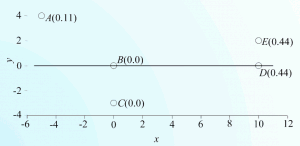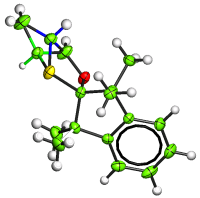 The CRYSTALS v14.43 installer is now available to download for the Windows platfom.
The CRYSTALS v14.43 installer is now available to download for the Windows platfom.
[Update: 14.43 is a bug fix release]
 The CRYSTALS v14.43 installer is now available to download for the Windows platfom.
The CRYSTALS v14.43 installer is now available to download for the Windows platfom.
[Update: 14.43 is a bug fix release]
J Appl. Cryst. (2012), 45, 417-429. [ doi:10.1107/S0021889812015191 ]
 Leverages measure the influence that observations (intensity data and restraints) have on the fit obtained in crystal structure refinement. Further analysis enables the influence that observations have on specific parameters to be measured. The results of leverage analyses are discussed in the context of the amino acid alanine and an incomplete high-pressure data set of the complex bis(salicylaldoximato)copper(II). Leverage analysis can reveal situations where weak data are influential and allows an assessment of the influence of restraints. Analysis of the high-pressure refinement of the copper complex shows that the influence of the highest-leverage intensity observations increases when completeness is reduced, but low leverages stay low. The influence of restraints, notably those applying the Hirshfeld rigid-bond criterion, also increases dramatically. In alanine the precision of the Flack parameter is determined by medium-resolution data with moderate intensities. The results of a leverage analysis can be incorporated into a weighting scheme designed to optimize the precision of a selected parameter. This was applied to absolute structure refinement of light-atom crystal structures. The standard uncertainty of the Flack parameter could be reduced to around 0.1 even for a hydrocarbon.
Leverages measure the influence that observations (intensity data and restraints) have on the fit obtained in crystal structure refinement. Further analysis enables the influence that observations have on specific parameters to be measured. The results of leverage analyses are discussed in the context of the amino acid alanine and an incomplete high-pressure data set of the complex bis(salicylaldoximato)copper(II). Leverage analysis can reveal situations where weak data are influential and allows an assessment of the influence of restraints. Analysis of the high-pressure refinement of the copper complex shows that the influence of the highest-leverage intensity observations increases when completeness is reduced, but low leverages stay low. The influence of restraints, notably those applying the Hirshfeld rigid-bond criterion, also increases dramatically. In alanine the precision of the Flack parameter is determined by medium-resolution data with moderate intensities. The results of a leverage analysis can be incorporated into a weighting scheme designed to optimize the precision of a selected parameter. This was applied to absolute structure refinement of light-atom crystal structures. The standard uncertainty of the Flack parameter could be reduced to around 0.1 even for a hydrocarbon.
Electronic reprints
Publisher’s copy
J. Appl. Cryst. (2011), 44, 1017-1022.   [ doi:10.1107/S0021889811034066 ]
A summary of the features for investigating absolute structure available in the crystallographic refinement program CRYSTALS is presented, together with the results of analyses of 150 light-atom structures collected with molybdenum radiation carried out with these tools. The results confirm that the Flack and Hooft parameters are strongly indicative, even when the standard uncertainties are large compared to the thresholds recommended by Flack & Bernardinelli [J. Appl. Cryst. (2000), 33, 1143–1148].
Electronic reprints
Publisher’s copy
 CRYSTALS v14.23c installer is available to download for the Windows platfom.
CRYSTALS v14.23c installer is available to download for the Windows platfom.
[Update – patched version 1423c released 27 May, fixes format problem with tiny weights in FCF, CIF input bug]
Selected highlights:
CRYSTALS v14.21 installer is available to download for the Windows platfom.
Selected highlights:
Acta Cryst. (2011), A67, 21-34. Â Â [ doi:10.1107/S010876731004287X ]
The practical use of the average and difference intensities of Friedel opposites at different stages of structure analysis has been investigated. It is shown how these values may be properly and practically used at the stage of space-group determination. At the stage of least-squares refinement, it is shown that increasing the weight of the difference intensities does not improve their fit to the model. The correct form of the coefficients for a difference electron-density calculation is given. In the process of structure validation, it is further shown that plots of the observed and model difference intensities provide an objective method to evaluate the fit of the data to the model and to reveal insufficiencies in the intensity measurements. As a further tool for the validation of structure determinations, the use of the Patterson functions of the average and difference intensities has been investigated and their clear advantage demonstrated.
Electronic reprints
Publisher’s copy
CRYSTALS v14.11 is available as a beta-test.
Many small changes in Regularise Replace thanks to a CRYSTALS workshop in Toulouse organised by Carine Duhayon and Laure Vendier.
Cif generator now properly includes esds on refined hydrogen bonds, has incrreased figure-fields for cell parameters, and appends constraint and restraint information as _iucr_ data items at end of cif.
Improved scaling of difference Pattersons – see forthcoming paper by Flack, Sadki, Thompson & Watkin.
Absolute configuration routine (based on PLATON with Ton Spek’s permission) extended to provide more diagnostics and additional data to be re-input as absolute-structure strengthening restraints (see paper by Flack et al. above).
Error tracking for “USE” files has been improved.
Collaboration with Ernesto Mesto (Dipartimento Geomineralogico – UniversitĂ degli Studi di Bari) uncovered over-sights in the original 1979 code, which lost contributions when a twin component fell onto a centring absence. Difference maps with twinned data now seem to reveal hydrogen atoms very reliably.
J. Appl. Cryst. (2010), 43, 1100-1107. Â Â [ doi:10.1107/S0021889810025598 ]
Because they scatter X-rays weakly, H atoms are often abused or neglected during structure refinement. The reasons why the H atoms should be included in the refinement and some of the consequences of mistreatment are discussed along with selected real examples demonstrating some of the features for hydrogen treatment that can be found in the software suite CRYSTALS.
Electronic reprints:
Publisher’s copy:
Acta Cryst. (2009), C65, o635-o638. Â Â [ doi:10.1107/S0108270109046952 ]
The unusual methylene aziridine 6-tert-butyl-3-oxa-2-thia-1-azabicyclo[5.1.0]oct-6-ene 2,2-dioxide, C9H15NO3S, was found to crystallize with two molecules in the asymmetric unit. The structure was solved in both the approximately orthogonal and the oblique settings of space group No. 14, viz. P21/n and P21/c, respectively. A comparison of these results clearly displayed an increase in the correlation between coordinates in the ac plane for the oblique cell. The increase in the corresponding covariances makes a significant contribution to the standard uncertainties of derived parameters, e.g. bond lengths. Since there is yet no CIF definition for the full variance-covariance matrix, there are clear advantages to reporting the structure in the nonstandard space-group setting.
Publisher’s copy: IUCr
Acta Cryst. (2009), E65, o2904-o2905. Â Â [ doi:10.1107/S1600536809043827 ]
X-ray crystallographic analysis of the title hydrobromide salt, C10H20N+Br-, of (1R,2S,3R,5R,8aR)-3-hydroxymethyl-5- methyloctahydroindolizine-1,2-diol defines the absolute and relative stereochemistry at the five chiral centres in steviamine, a new class of polyhydroxylated indolizidine alkaloid isolated from Stevia rebaudiana (Asteraceae) leaves.
Electronic reprint:
Publisher’s copy: